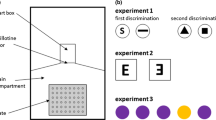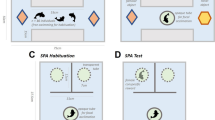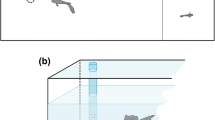Abstract
In several mammalian and avian species, females show a higher performance than males in tasks requiring cognitive flexibility such as the discrimination reversal learning. A recent study showed that female guppies are twice as efficient as males in a reversal learning task involving yellow–red discrimination, suggesting a higher cognitive flexibility in female guppies. However, the possibility exists that the superior performance exhibited by females does not reflect a general sex difference in cognitive abilities, but instead, is confined to colour discrimination tasks. To address this issue, we compared male and female guppies in two different discrimination reversal learning tasks and we performed a meta-analysis of these experiments and the previous one involving colour discrimination. In the first experiment of this study, guppies were tested in a task requiring them to learn to select the correct arm of a T-maze in order to rejoin a group of conspecifics. In experiment 2, guppies were observed in a numerical task requiring them to discriminate between 5 and 10 dots in order to obtain a food reward. Although females outperformed males in one condition of the T-maze, we did not find any clear evidence of females’ greater reversal learning performance in either experiment. However, the meta-analysis of the three experiments supported the hypothesis of females’ greater reversal learning ability. Our data do not completely exclude the idea that female guppies have a generally higher cognitive flexibility than males; however, they suggest that the size of this sex difference might depend on the task.




Similar content being viewed by others
References
Agrillo C, Bisazza A (2014) Spontaneous versus trained numerical abilities. A comparison between the two main tools to study numerical competence in non-human animals. J Neurosci Met 234:82–91
Agrillo C, Miletto Petrazzini ME, Bisazza A (2017) Numerical abilities in fish: a methodological review. Behav Process 141:161–171
Barchard KA (2015) Null hypothesis significance testing does not show equivalence. Anal Soc Issues Public Policy 15:418–421
Bisazza A, Brown C (2011) Lateralization of cognitive functions in fish. In: Brown C, Krause J, Laland KN (eds) Fish cognition and behavior. Wiley, Oxford, pp 298–324
Bisazza A, Facchin L, Pignatti R, Vallortigara G (1998) Lateralization of detour behaviour in poeciliid fish: the effect of species, gender and sexual motivation. Behav Brain Res 91:157–164
Brust V, Wuerz Y, Krüger O (2013) Behavioural flexibility and personality in zebra finches. Ethology 119:559–569
Burghardt GM, Hess EH (1966) Food imprinting in the snapping turtle, Chelydra serpentina. Science 151:108–109
Crawley MJ (2012) The R book. Wiley, Chichester
Croze H (1970) Searching image in carrion crows. Paul Parey, Berlin
Dugatkin LA, Godin JGJ (1992) Reversal of female mate choice by copying in the guppy (Poecilia reticulata). Proc R Soc Lond Ser B Biol Sci 249:179–184
Eakley AL, Houde AE (2004) Possible role of female discrimination against ‘redundant’ males in the evolution of colour pattern polymorphism in guppies. Proc R Soc Lond Ser B Biol Sci 271:S299–S301
Elias MF, Dupree M, Eleftheriou BE (1973) Differences in spatial discrimination reversal learning between two inbred mouse strains following specific amygdaloid lesions. J Comp Physiol Psychol 83:149–156
Feigenson L, Carey S, Spelke E (2002) Infants’ discrimination of number vs. continuous extent. Cogn Psychol 44:33–66
Gasparini C, Serena G, Pilastro A (2013) Do unattractive friends make you look better? Context-dependent male mating preferences in the guppy. Proc R Soc Lond Ser B Biol Sci 280:20123072
Gaulin SJ, FitzGerald RW (1986) Sex differences in spatial ability: an evolutionary hypothesis and test. Am Nat 127:74–88
Gebuis T, Reynvoet B (2012) The interplay between nonsymbolic number and its continuous visual properties. J Exp Psychol Gen 141:642–648
Godin JGJ, Herdman EJ, Dugatkin LA (2005) Social influences on female mate choice in the guppy, Poecilia reticulata: generalized and repeatable trait-copying behaviour. Anim Behav 69:999–1005
Gómez-Laplaza LM, Gerlai R (2010) Latent learning in zebrafish (Danio rerio). Behav Brain Res 208:509–515
Gong A, Gibson RM (1996) Reversal of a female preference after visual exposure to a predator in the guppy, Poecilia reticulata. Anim Behav 52:1007–1015
Grether GF (2000) Carotenoid limitation and mate preference evolution: a test of the indicator hypothesis in guppies (Poecilia reticulata). Evolution 54:1712–1724
Griffin AS, Guillette LM, Healy SD (2015) Cognition and personality: an analysis of an emerging field. Trends Ecol Evol 30:207–214
Guillamón A, Valencia A, Calés J, Segovia S (1986) Effects of early postnatal gonadal steroids on the successive conditional discrimination reversal learning in the rat. Physiol Behav 38:845–849
Ha JC, Mandell DJ, Gray J (2011) Two-item discrimination and Hamilton search learning in infant pigtailed macaque monkeys. Behav Process 86:1–6
Houde AE (1997) Sex, color, and mate choice in guppies. Princeton University Press, Princeton
Hughes KA, Du L, Rodd FH, Reznick DN (1999) Familiarity leads to female mate preference for novel males in the guppy, Poecilia reticulata. Anim Behav 58:907–916
Jeffreys H (1961) Theory of probability, 3rd edn. Oxford University Press, Oxford
Kellogg WN, Gavin J (1960) Maze-learning in the guppy. Psychol Rep 6:445–446
Kodric-Brown A (1989) Dietary carotenoids and male mating success in the guppy: an environmental component to female choice. Behav Ecol Sociobiol 25:393–401
Lakens D, Evers ER (2014) Sailing from the seas of chaos into the corridor of stability: practical recommendations to increase the informational value of studies. Perspect Psychol Sci 9:278–292
Laland KN, Reader SM (1999) Foraging innovation in the guppy. Anim Behav 57:331–340
Liu Y, Burmeister SS (2017) Sex differences during place learning in the túngara frog. Anim Behav 128:61–67
Lucon-Xiccato T, Bisazza A (2014) Discrimination reversal learning reveals greater female behavioural flexibility in guppies. Biol Lett 10:20140206
Lucon-Xiccato T, Bisazza A (2016) Male and female guppies differ in speed but not in accuracy in visual discrimination learning. Anim Cogn 19:733–744
Lucon-Xiccato T, Bisazza A (2017a) Sex differences in spatial abilities and cognitive flexibility in the guppy. Anim Behav 123:53–60
Lucon-Xiccato T, Bisazza A (2017b) Complex maze learning by fish. Anim Behav 125:69–75
Lucon-Xiccato T, Bisazza A (2017c) Individual differences in cognition among teleost fishes. Behav Process 141:184–195
Lucon-Xiccato T, Miletto Petrazzini ME, Agrillo C, Bisazza A (2015) Guppies discriminate between two quantities of food items but prioritize item size over total amount. Anim Behav 107:183–191
Lucon-Xiccato T, Dadda M, Bisazza A (2016) Sex differences in discrimination of shoal size in the guppy (Poecilia reticulata). Ethology 122:481–491
Mackintosh NJ (1965) Overtraining, reversal, and extinction in rats and chicks. J Comp Physiol Psychol 59:31–36
Mackintosh NJ, Mackintosh J, Safriel-Jorne O, Sutherland NS (1966) Overtraining, reversal and extinction in the goldfish. Anim Behav 14:314–318
Mandler G, Shebo BJ (1982) Subitizing: an analysis of its component processes. J Exp Psychol Gen 111:1–22
Miletto Petrazzini ME, Agrillo C, Izard V, Bisazza A (2015a) Relative versus absolute numerical representation in fish: can guppies represent “fourness”? Anim Cogn 18:1007–1017
Miletto Petrazzini ME, Lucon-Xiccato T, Agrillo C, Bisazza A (2015b) Use of ordinal information by fish. Sci Rep 5:15497
Persons MH, Rypstra AL (2000) Preference for chemical cues associated with recent prey in the wolf spider Hogna helluo (Araneae: Lycosidae). Ethology 106:27–35
Pisa PE, Agrillo C (2009) Quantity discrimination in felines: a preliminary investigation of the domestic cat (Felis silvestris catus). J Ethol 27:289–293
Rabinowitch V (1969) The role of experience in the development and retention of seed preferences in zebra finches. Behaviour 33:222–235
Reddon AR, Hurd PL (2009) Sex differences in the cerebral lateralization of a cichlid fish when detouring to view emotionally conditioned stimuli. Behav Process 82:25–29
Rilea SL, Roskos-Ewoldsen B, Boles D (2004) Sex differences in spatial ability: a lateralization of function approach. Brain Cogn 56:332–343
Rodd FH, Hughes KA, Grether GF, Baril CT (2002) A possible non-sexual origin of mate preference: are male guppies mimicking fruit? Proc R Soc Lond Ser B Biol Sci 269:475–481
Roelofs S, Nordquist RE, van der Staay FJ (2017) Female and male pigs’ performance in a spatial holeboard and judgment bias task. Appl Anim Behav Sci. doi:10.1016/j.applanim.2017.01.016
Rogers LJ (1974) Persistence and search influenced by natural levels of androgens in young and adult chickens. Physiol Behav 12:197–204
Rowe L, Cameron E, Day T (2005) Escalation, retreat, and female indifference as alternative outcomes of sexually antagonistic coevolution. Am Nat 165:S5–S18
Shettleworth SJ (2010) Cognition, evolution, and behavior. Oxford University Press, Oxford
Tinbergen L (1960) The natural control of insects in pinewoods. Arch Neerl Zool 13:265–343
Titulaer M, van Oers K, Naguib M (2012) Personality affects learning performance in difficult tasks in a sex-dependent way. Anim Behav 83:723–730
Tommasi L, Vallortigara G (2004) Hemispheric processing of landmark and geometric information in male and female domestic chicks (Gallus gallus). Behav Brain Res 155:85–96
Viechtbauer W (2010) Conducting meta-analyses in R with the metafor package. J Stat Softw 36:1–48
Wagenmakers EJ (2007) A practical solution to the pervasive problems of p values. Psychon Bull Rev 14:779–804
Warren JM (1960) Reversal learning by paradise fish (Macropodus opercularis). J Comp Physiol Psychol 53:376–378
Watson DJ, Stanton ME (2009) Intrahippocampal administration of an NMDA-receptor antagonist impairs spatial discrimination reversal learning in weanling rats. Neurobiol Learn Mem 92:89–98
Acknowledgements
We would like to thank Immacolata Orrù and Jacqueline Giada Mazzon for their help in testing the animals. This study was founded by “PRIN 2015” (prot.: 2015FFATB7) from the University of Padova to Angelo Bisazza.
Author information
Authors and Affiliations
Corresponding author
Ethics declarations
Conflict of interest
The authors declare that they have no conflict of interest.
Ethical standard
Experiments were conducted in agreement with the law of our country (Italy, D.L. 4 Marzo 2014, n. 26). The Ethical Committee of the University of Padova reviewed and approved the experimental procedures (Protocol n. 33/2015 and n. 22/2016). None of the subjects showed sign of distress. At the end of the experiments, all subjects were released into the maintenance tanks.
Rights and permissions
About this article
Cite this article
Miletto Petrazzini, M.E., Bisazza, A., Agrillo, C. et al. Sex differences in discrimination reversal learning in the guppy. Anim Cogn 20, 1081–1091 (2017). https://doi.org/10.1007/s10071-017-1124-4
Received:
Revised:
Accepted:
Published:
Issue Date:
DOI: https://doi.org/10.1007/s10071-017-1124-4




